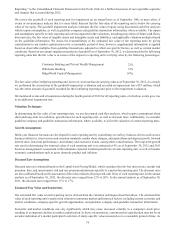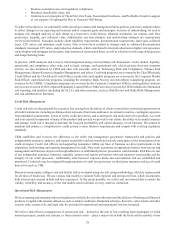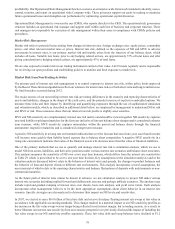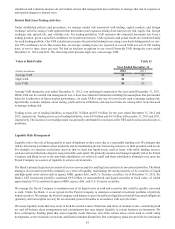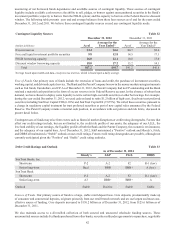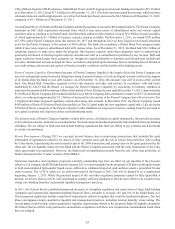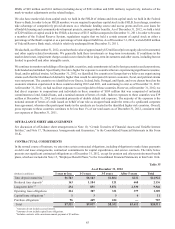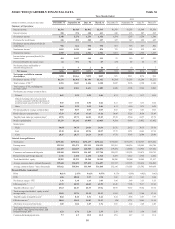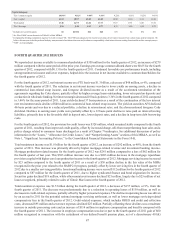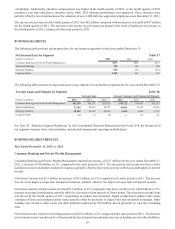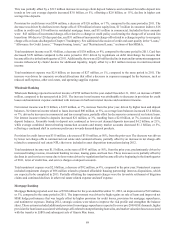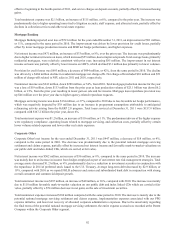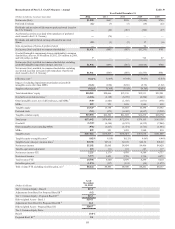SunTrust 2012 Annual Report Download - page 100
Download and view the complete annual report
Please find page 100 of the 2012 SunTrust annual report below. You can navigate through the pages in the report by either clicking on the pages listed below, or by using the keyword search tool below to find specific information within the annual report.
84
Other Liquidity Considerations. As presented in Table 34, we had an aggregate potential obligation of $63.6 billion to our
clients in unused lines of credit at December 31, 2012. Commitments to extend credit are arrangements to lend to clients who
have complied with predetermined contractual obligations. We also had $4.1 billion in letters of credit as of December 31,
2012, most of which are standby letters of credit, which require that we provide funding if certain future events occur.
Approximately $2.1 billion of these letters supported variable rate demand obligations as of December 31, 2012.
As of December 31, 2012, our liability for UTBs was $137 million and the liability for interest related to these UTBs was
$18 million. The UTBs represent the difference between tax positions taken or expected to be taken in our tax returns and the
benefits recognized and measured in accordance with the relevant accounting guidance for income taxes. The UTBs are based
on various tax positions in several jurisdictions, and if taxes related to these positions are ultimately paid, the payments would
be made from our normal operating cash flows, likely over multiple years.
Unfunded Lending Commitments Table 34
(Dollars in millions) December 31, 2012 December 31, 2011
Unused lines of credit:
Commercial $36,902 $35,685
Mortgage commitments19,152 7,833
Home equity lines 11,739 12,730
Commercial real estate 1,684 1,465
CP conduit —765
Credit card 4,075 3,526
Total unused lines of credit $63,552 $62,004
Letters of credit:
Financial standby $3,993 $5,081
Performance standby 49 70
Commercial 56 55
Total letters of credit $4,098 $5,206
1Includes IRLC contracts with notional balances of $6.8 billion and $4.9 billion as of December 31, 2012 and 2011, respectively.
Other Market Risk
Other sources of market risk include the risk associated with holding residential and commercial mortgage loans prior to
selling them into the secondary market, commitments to clients to make mortgage loans that will be sold to the secondary
market, and our investment in MSRs. We manage the risks associated with the residential and commercial mortgage LHFS
(i.e., the warehouse) and our IRLCs on residential loans intended for sale. The warehouses and IRLCs consist primarily of
fixed and adjustable rate single family residential and commercial real estate loans. The risk associated with the warehouses
and IRLCs is the potential change in interest rates between the time the customer locks the rate on the anticipated loan and
the time the loan is sold on the secondary market, which is typically 60-150 days.
We manage interest rate risk predominantly with interest rate swaps, futures, and forward sale agreements, where the changes
in value of the instruments substantially offset the changes in value of the warehouse and the IRLCs. The IRLCs on residential
mortgage loans intended for sale are classified as derivative financial instruments and are not designated as hedge accounting
relationships.
MSRs are the present value of future net cash flows that are expected to be received from the mortgage servicing portfolio.
The value of MSRs is highly dependent upon the assumed prepayment speed of the mortgage servicing portfolio which is
driven by the level of certain key interest rates, primarily the 30-year current coupon par mortgage rate. Future expected net
cash flows from servicing a loan in the mortgage servicing portfolio would not be realized if the loan pays off earlier than
anticipated. Given the 80 basis points drop in rates, prepayments for 2012 were up significantly over 2011 but were more
than offset by growth in new MSRs additions during the year.
MSRs, which are carried at fair value, totaled $899 million and $921 million as of December 31, 2012 and 2011, respectively,
are managed within established risk limits and are monitored as part of various governance processes. We recorded declines
of $353 million and $733 million in the fair value of our MSRs for the years ended December 31, 2012 and 2011, respectively.
Increases or decreases in fair value include the decay resulting from the realization of expected monthly net servicing cash
flows. For the years ended December 31, 2012 and 2011, we originated MSRs with fair values at the time of origination of
$336 million and $224 million, respectively. For the years ended December 31, 2012 and 2011, we recorded losses related to


